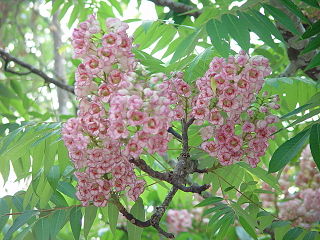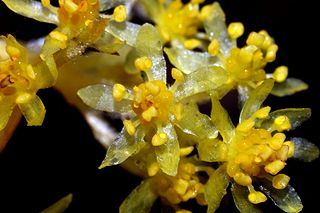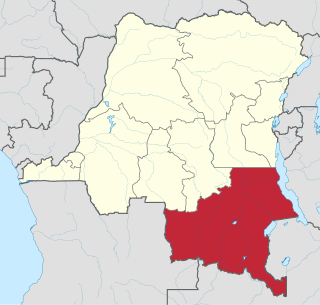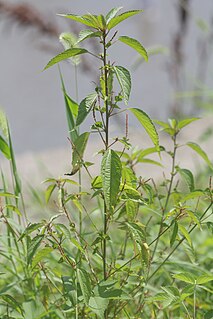
Pinus armandii, the Armand pine or Chinese white pine, is a species of pine native to China, occurring from southern Shanxi west to southern Gansu and south to Yunnan, with outlying populations in Anhui. It grows at altitudes of 2200–3000 m in Taiwan, and it also extends a short distance into northern Burma. In Chinese it is known as "Mount Hua pine" (华山松).

Acalypha rubrinervis is an extinct plant in the spurge family (Euphorbiaceae), from the island of Saint Helena in the South Atlantic Ocean. It was called string tree on account of the thin pendulous inflorescences which resembled red strings. Disturbance following human settlement on the island destroyed its habitat and it was last seen in the 19th century. It is thus one of a number of island plants to have been driven to extinction by human activity.

Pinanga tashiroi is a species of palm tree in the family Arecaceae. It is a small tree, up to 5 m (16 ft) tall, swollen at base. It is a critically endangered species.
Acalypha raivavensis is a species of plant in the family Euphorbiaceae. It is endemic to French Polynesia.
Acalypha suirenbiensis is a species of plant in the family Euphorbiaceae. It is endemic to Hualien County, Taiwan. The Flora of China, however, includes Acalypha hontauyuensis from Orchid Island in this species. It is a shrub growing about 3 m (10 ft) tall.
Acer duplicatoserratum is a species of maple, native to southern and eastern mainland China and Taiwan.

Bretschneidera sinensis, the sole species in genus Bretschneidera, is a rare, 10–20 metres (33–66 ft) tall tree with large inflorescences. It is found in south and east of China, Taiwan, northern Thailand and northern Vietnam. It is threatened by habitat loss. Because of its relatively recent discovery in Taiwan and Thailand, it is possible that it could also be found in Laos and northern Myanmar. It was named in honor of Emil Bretschneider.
Eurya rengechiensis is a species of plant in the family Pentaphylacaceae. It is endemic to Taiwan and found only near Taichung. Eurya rengechiensis is an evergreen small tree.

Fagus hayatae, also known as Taiwan beech, is a species of beech tree. It can grow 20 metres (66 ft) tall.It is the only beech species native to Taiwan. While IUCN reports it, as endemic to Taiwan, "Flora of China" and "Flora of Taiwan" also report it from China; "Flora of China" reports a wide but discontinuous mainland distribution between Sichuan in the southwest to Zhejiang in the east.

Helicia is a genus of 110 species of trees and shrubs, constituting part of the plant family Proteaceae. They grow naturally in rainforests throughout tropical South and Southeast Asia, including India, Sri Lanka, Indochina, Peninsular Malaysia to New Guinea and as far south as New South Wales.
Ligustrum pricei is a species of Ligustrum, native to China and Taiwan, where it occurs at 900–1700 m altitude.

Mahonia oiwakensis is a species of plant in the barberry family, Berberidaceae. It is native to Taiwan, China and Myanmar, where it occurs at elevations of 600 to 3800 m. It has recently been found naturalized in South Africa.
Neolitsea daibuensis is a species of plant in the family Lauraceae endemic to Taiwan. It is a small semi-deciduous tree that grows in the broad-leaved forests in southern Taiwan at altitudes of 800–1,000 m (2,600–3,300 ft). It is threatened by habitat loss.
Lithocarpus dodonaeifolius is a species of tree in the family Fagaceae. L. dodonaeifolius is a medium-sized tree, up to 9 m (30 ft) tall. It is endemic to Taiwan and only occurs in the Hengchun Peninsula in the extreme south of the country. It grows in mixed mesophytic forests at altitudes of 500–1,500 m (1,600–4,900 ft).
Lithocarpus formosanus is a species of tree in the family Fagaceae. L. formosanus is a medium-sized tree with crooked trunk and many branches. It is endemic to Taiwan as it only occurs in the Hengchun Peninsula in the extreme south of the country. It grows in mixed mesophytic forests at altitudes of 100–500 m (330–1,640 ft). Only single population of fewer than 50 individuals survives.

Sassafras randaiense is a species of deciduous tree in the family Lauraceae belonging to the genus Sassafras. It is a relict species endemic to Taiwan. It is threatened by habitat loss.

Cinnamomum osmophloeum, commonly known as pseudocinnamomum or indigenous cinnamon, is a medium-sized evergreen tree in the genus Cinnamomum. It is native to broad-leaved forests of central and northern Taiwan.
The Flora of Taiwan is the flora of the country also known as the Republic of China.

Acalypha dikuluwensis was a 25 centimetres (9.8 in) high tropical flowering plant in the genus Acalypha of the family Euphorbiaceae. The IUCN Red List of Threatened Species declared the plant extinct in 2012. A. dikuluwensis was endemic to copper-rich soils of eastern Katanga Province of the Democratic Republic of the Congo, and was only found around Dikuluwe. The soils are derived from Katanga Supergroup Upper Cambrian Roan Group rocks. It was restricted to steppic savanna in copper outcrops, which were destroyed by surface mining. No specimens were found after 1959.

Acalypha australis, commonly known as Asian copperleaf, is a species of flowering plant in the family Euphorbiaceae native to eastern Asia.











